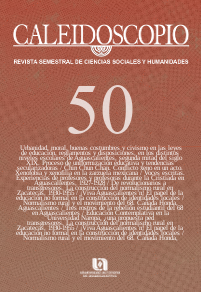The study of the visual and narrative voices of childhood, a methodological proposal
DOI:
https://doi.org/10.33064/50crscsh5048Keywords:
Childhood, Visual representation, voiceAbstract
Girls and boys, as social beings in their own right, have a unique way of expressing themselves, not only through words, but also through visual representations. Faced with the problem of the lack of social participation of children, we found that their drawings, photographs, or any other type of visual representation, can trigger a visual-narrative dialogue, which offers a window into their thoughts, emotions, and perceptions of the world. This article supports the need to study such representations and narratives, and based on the theory of voice developed by Nick Couldry, as well as the approach of the sociology of childhood, a methodology developed on visual ethnography methods is presented here, designed to be applied in a research study in the city of Aguascalientes, Mexico, but with the possibility of being replicated in other social contexts. The results of this investigation are not presented in this article, since its approach is merely methodological.
Downloads
References
Berger, J. (2011). Sobre el dibujo. Gustavo Gili.
Burke, C. (2009). “Play in focus”: children’s visual voice in participative research. En P. Thomson (Ed.), Doing visual research with children and young people. Routledge.
Couldry, N. (2010). Why voice matters, culture and politics after neoliberalism. Sage. DOI: https://doi.org/10.4135/9781446269114
Freedman, K. (2003). Teaching visual culture. Curriculum, aesthetics, and the social life of art. Teacher College Press.
Hall, E. (2015). The ethics of “using” children’s drawing in research. En E. Stirling y D. Yamada-Rice (Eds.), Visual methods with children and young people: academics and visual industries in dialogue (I ed. pp.viii-ix). Palgrave Macmillan.
Hamelink, C. (2021). The EU democratic deficit: donkeys and children. IAMCR Nairobi Conference 2021.
Kress, G. y Van Leeuwen, T. (2021). Reading images, the grammar of visual design (3a ed.). Perlego. DOI: https://doi.org/10.4324/9781003099857
Martuccelli, D. (2002). Grammaries de l’Individu. Gallimard.
Mayall, B. (2000). The Sociology of Childhood in Relation to Children's Rights. The International Journal of Children's Rights, 8. 243-259. https://doi.org/10.1163/15718180020494640. DOI: https://doi.org/10.1163/15718180020494640
Mayall, B. (2002). Towards a sociology for childhood. Thinking from children ́s lives. Open University Press.
Morales, S. y Magistris, G. (2019). Hacia un paradigma otro: niñxs como sujetxs políticxs co-protagonistas de la transformación social. En G. P. Magistris y S. Morales (Eds.),Niñez en movimiento: del adultocentrismo a la emancipación. Editorial Chirimbote.
Núñez Patiño, K. (2020). Escuela y procesos de construcción identitaria en la niñez indígena desde los dibujos en diálogo. Educação e Pesquisa, 46, e237748. https://doi.org/10.1590/S1678-4634202046237748 DOI: https://doi.org/10.1590/s1678-4634202046237748
Pavez Soto, I., Sepúlveda Kattan, N. (2019). Concepto de agencia en los estudios de infancia. Una revisión teórica, Sociedad e Infancias, 3, 193-210. DOI: https://doi.org/10.5209/soci.63243
Parry, B. (2015). Arts-based approaches to research with children en E. Stirling y D. Yamada-Rice (Eds.) Visual methods with children and young people: academics and visual industries in dialogue (pp.89-98). Palgrave Macmillan. DOI: https://doi.org/10.1057/9781137402295_6
Stirling, E. y Yamada-Rice, D. (Eds.) (2015). Visual methods with children and young people : academics and visual industries in dialogue. Palgrave Macmillan. DOI: https://doi.org/10.1057/9781137402295
Thomson, P. (Ed.) (2009). Doing visual research with children and young people. Routledge. DOI: https://doi.org/10.4324/9780203870525
Wood, E. (2015). Ethics, voices and visual methods. En E. Stirling y D. Yamada-Rice (Eds.) Visual methods with children and young people: academics and visual industries in dialogue (pp.129-139). Palgrave Macmillan. DOI: https://doi.org/10.1057/9781137402295_9
Downloads
Published
How to Cite
Issue
Section
License
Copyright (c) 2024 Paola María Garfias Cedillo

This work is licensed under a Creative Commons Attribution-NonCommercial-ShareAlike 4.0 International License.
Licencia Creative Commons Atribución-NoComercial-CompartirIgual 4.0 Internacional
El lector es libre de compartir o adaptar el material en cualquier medio o formato bajo las condiciones siguientes: (a) debe reconocer adecuadamente la autoría, proporcionar un enlace a la licencia e indicar si se han realizado cambios; (b) no puede utilizar el material para una finalidad comercial y (c) si remezcla, transforma o crea a partir del material, deberá difundir sus contribuciones bajo la misma licencia que el original.
Resumen de la licencia
https://creativecommons.org/licenses/by-nc-sa/4.0/deed.es_ES
Texto completo de la licencia
https://creativecommons.org/licenses/by-nc-sa/4.0/legalcode
Cada autor es responsable del contenido de su artículo. En el caso de un texto colectivo, el primer autor asume la responsabilidad intelectual de los resultados del proceso editorial; los autores son responsables de obtener la licencia de autor para reproducir materiales gráficos o fotográficos que pertenecen a terceros.
Los autores asumen plena responsabilidad en el caso de falsificación de datos o falta de autenticidad en la investigación. Se comprometen, también, a no reutilizar trabajos ya publicados, total o parcialmente, para presentarlos en otra publicación.
Estas condiciones aplican tanto a la versión impresa como a la versión electrónica de la revista.


















